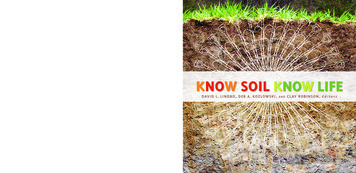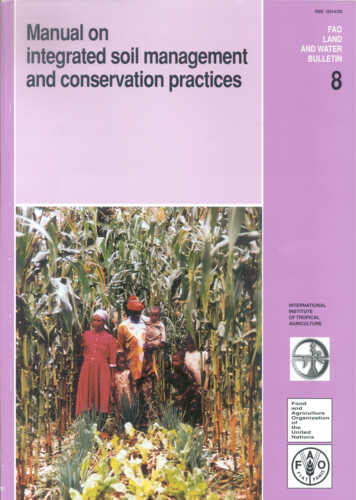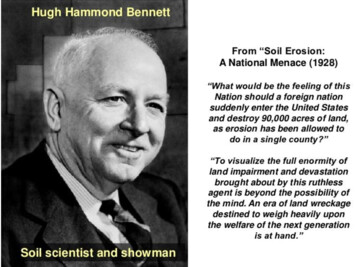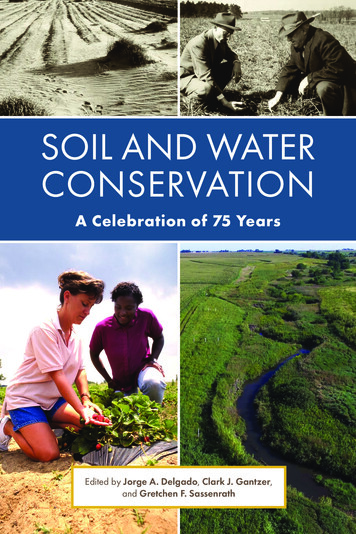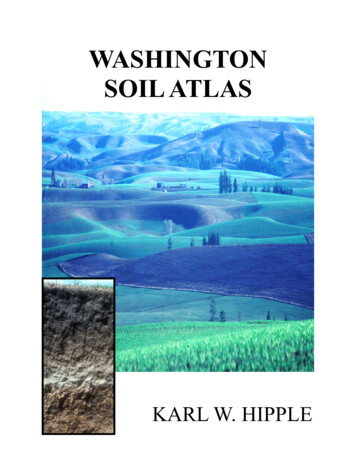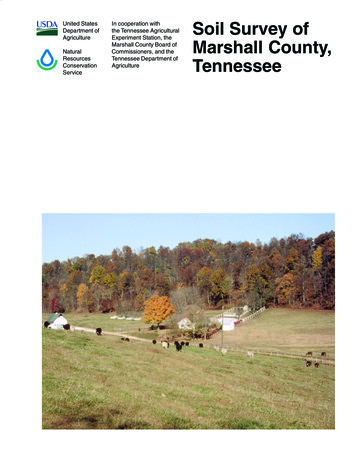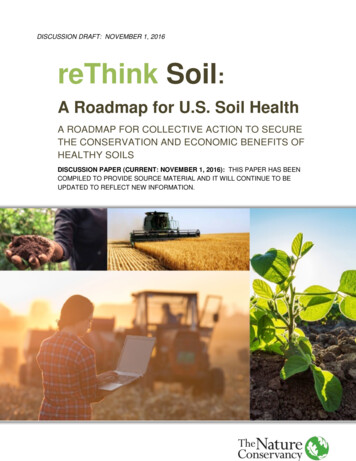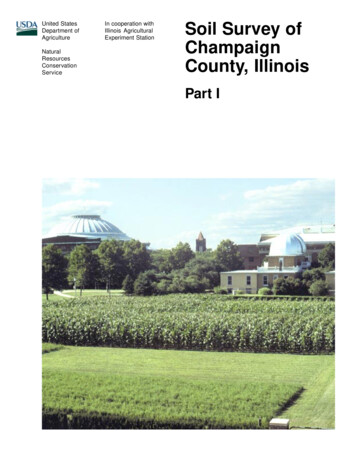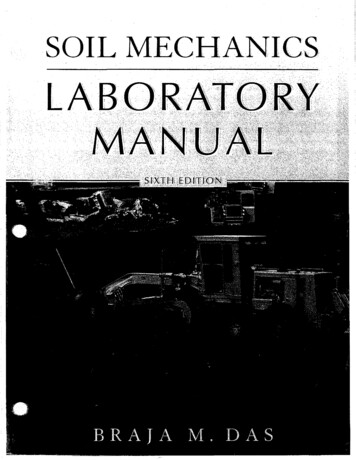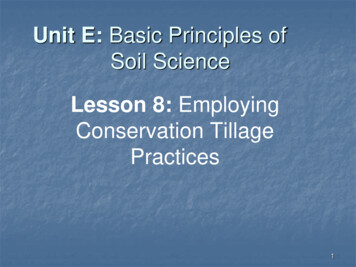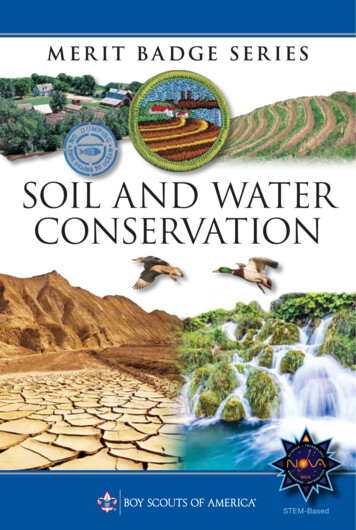
Transcription
SOIL AND WATERCONSERVATIONSTEM-Based
BOY SCOUTS OF AMERICAMERIT BADGE SERIESSOIL AND WATERCONSERVATION“Enhancing our youths’ competitive edge through merit badges”
Requirements1. Do the following:a. Tell what soil is. Tell how it is formed.b. Describe three kinds of soil. Tell how they are different.c. Name the three main plant nutrients in fertile soil. Tellhow they can be put back when used up.2. Do the following:a. Define soil erosion.b. Tell why soil erosion is important. Tell how itaffects you.c. Name three kinds of soil erosion. Describe each.d. Take pictures of or draw two kinds of soil erosion.3. Do the following:a. Tell what is meant by “conservation practices.”b. Describe the effect of three kinds oferosion-control practices.c. Take pictures of or draw three kinds oferosion-control practices.4. Do the following:a. Explain what a watershed is.b. Outline the smallest watershed that you can findon a contour map.c. Outline, as far as the map will allow, the next largerwatershed that also has the smaller one in it.SOIL AND WATER CONSERVATION 3
d. Explain what a river basin is. Tell why all people livingin a river basin should be concerned about land andwater use in the basin.e. Explain what an aquifer is and why it can be importantto communities.5. Do the following:a. Make a drawing to show the hydrologic cycle.b. Demonstrate at least two of the following actions ofwater in relation to soil: percolation, capillary action,precipitation, evaporation, transpiration.c. Explain how removal of vegetation will affect the waywater runs off a watershed.d. Tell how uses of forest, range, and farmland affect usablewater supply.e. Explain how industrial use affects water supply.6. Do the following:a. Tell what is meant by “water pollution.”b. Describe common sources of water pollution and explainthe effects of each.c. Tell what is meant by “primary water treatment,”“secondary waste treatment,” and “biochemicaloxygen demand.”d. Make a drawing showing the principles of completewaste treatment.7. Do TWO of the following:a. Make a trip to two of the following places. Write a reportof more than 500 words about the soil and water andenergy conservation practices you saw.(1) An agricultural experiment(2) A managed forest or a woodlot, range, or pasture(3) A wildlife refuge or a fish or gamemanagement area(4) A conservation-managed farm or ranch(5) A managed watershed4 SOIL AND WATER CONSERVATION
(6) A waste-treatment plant(7) A public drinking-water treatment plant(8) An industry water-use installation(9) A desalinization plantb. Plant 100 trees, bushes, and/or vines for agood purpose.c. Seed an area of at least one-fifth acre for someworthwhile conservation purposes, using suitablegrasses or legumes alone or in a mixture.d. Study a soil survey report. Describe the things in it.Using tracing paper and pen, trace over any of the soilmaps and outline an area with three or more differentkinds of soil. List each kind of soil by full name andmap symbol.e. Make a list of places in your neighborhood, camps,school ground, or park that have erosion, sedimentation,or pollution problems. Describe how these could becorrected through individual or group action.f. Carry out any other soil and water conservation projectapproved by your merit badge counselor.SOIL AND WATER CONSERVATION 5
Resources.ResourcesScouting LiteratureFieldbook; Animal Science, Architectureand Landscape Architecture, Backpacking,Environmental Science, Farm Mechanics,Fish and Wildlife Management, Forestry,Gardening, Mining in Society, Nature,Oceanography, Orienteering, Plant Science,and Sustainability merit badge pamphletsVisit the Boy Scouts of America’sofficial retail website at http://www.scoutstuff.org for a completelisting of all merit badge pamphletsand other helpful Scouting materials and supplies.Books About ConservationBramwell, Martyn. The Environmentand Conservation. PrenticeHall, 1992.Crawford, Leslie, and Cathy Anderson(ed.). Water Conservation(Environmental Action). DaleSeymour Publications, 1997.DeGalan, Julie, and Bryon Middlekauff.Great Jobs for Environmental StudiesMajors. McGraw-Hill, 2008.de Villiers, Marq. Water: The Fate ofOur Most Precious Resource. MarinerBooks, 2001.Doyle, Kevin, et al. The Complete Guideto Environmental Careers in the 21stCentury. Island Press, 1998.94 SOIL AND WATER CONSERVATIONFeinstein, Stephen. Conserving andProtecting Water: What You Can Do.Enslow Publishers, 2010.Fradkin, Philip L. A River No More:The Colorado River and the West.University of California Press, 1996.Gardner, Robert. Soil: Green ScienceProjects for a Sustainable Planet.Enslow Publishers, 2014.Greenland, Paul R. Career Opportunitiesin Conservation and theEnvironment. Ferguson, 2007.Leinwand, Gerald. The Environment(American Issues). Facts onFile, 1990.Lucas, Eileen. Naturalists,Conservationists, andEnvironmentalists (AmericanProfiles). Facts on File, 1994.———. Water: A Resource in Crisis.Children’s Press, 1991.Morgan, R.P.C. Soil Erosion andConservation, 3rd ed. BlackwellPublishing, 2005.Rothfeder, Jeffrey. Every Drop for Sale:Our Desperate Battle Over Waterin a World About to Run Out.Tarcher, 2004.Stille, Darlene R. Soil: Digging intoEarth’s Vital Resource. CompassPoint Books, 2005.
.ResourcesOrganizations and WebsitesChesapeake Bay ProgramToll-free telephone: 800-968-7229Website: http://www.chesapeakebay.netEnviroLink NetworkWebsite: http://www.envirolink.orgEnvironmental Protection AgencyAriel Rios Building1200 Pennsylvania Ave., NWWashington, DC 20460Telephone: 202-272-0167Website: http://www.epa.gov andhttp://water.epa.govNatural ResourcesConservation ServiceTelephone: 202-720-3210Websites: http://www.nrcs.usda.gov dgmentsThe Boy Scouts of America thanks GaryM. Stolz, Ph.D., U.S. Fish and WildlifeService, and the USDA Natural ResourcesConservation Service for their technicalexpertise and guidance during therevision of this merit badge pamphlet.The Boy Scouts of America isgrateful to the men and women servingon the Merit Badge Maintenance TaskForce for the improvements made inupdating this pamphlet.The Boy Scouts of America thanksthe following for their help with previouseditions of this pamphlet, upon whichthis edition is based: Jerry Bernard,Ken Carter, Bruce Dubee, Doug Holy,Tarleton A. Jenkins, Walter E. Jeske,Ted Kupelian, Katherine N. Mergen,Paul Reich, and Robert F. Tegner of theNatural Resources Conservation Service,U.S. Department of Agriculture, withthe counsel and technical assist-ance ofother personnel of the Natural ResourcesConservation Service. We also appreciateEd Partington, Environmental ProtectionAgency, for his assistance.Photo and Illustration Credits 2000 Oregon State University/C. Daly, G.Taylor, and J. Aiken, courtesy—page 29Florida Department of EnvironmentalProtection/Dana Denson, courtesy—page 93 (snail)HAAP Media Ltd., courtesy—cover (ducks)HAAP Media Ltd./Andrew Beierle,courtesy—cover (“no dumping” sign)Ferenc Lakatos, University of WestHungary, Bugwood.org, courtesy—page 93 (caterpillar)Longhorn Council, Boy Scouts ofAmerica, courtesy—page 53NASA Jet Propulsion Laboratory,courtesy—page 52Natural Resources Conservation Service,courtesy—pages 20–21 (both), 25, 35,40, and 50 (grassed waterway)Natural Resources Conservation Service/Lynn Betts, courtesy—cover (contouring); pages 37 (flood erosion), 39(sheet, gully, and rill erosion), 43, 47,48 (contouring), 54 (duck), 56–57(watershed dams), 67, and 79Natural Resources Conservation Service/Kurt Blume, courtesy—page 51(sediment basin)Natural Resources Conservation Service/Erwin C. Cole, courtesy—cover(farm community)Natural Resources Conservation Service/Jim Fortner, courtesy—page 17(soil profile)Natural Resources Conservation Service/Fred Gasper, courtesy—page 37(farming erosion)SOIL AND WATER CONSERVATION 95
Tarleton A. Jenkins, Walter E. Jeske, Ted Kupelian, Katherine N. Mergen, Paul Reich, and Robert F. Tegner of the Natural Resources Conservation Service, U.S. Department of Agriculture, with the counsel and technical assist-ance of other personnel of the Natural Resources Conservation Service. We also appreciate
